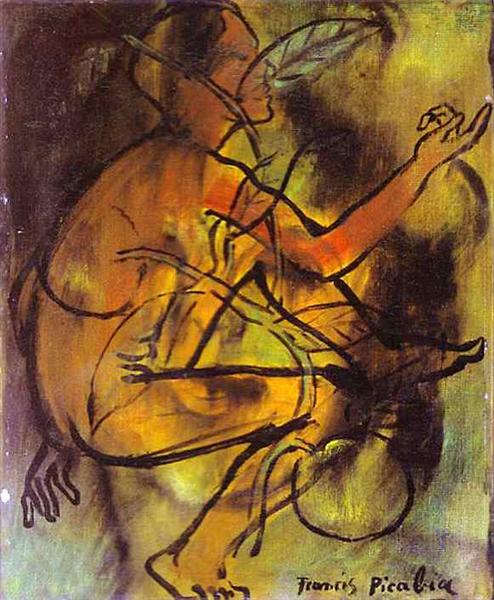Description
Francis Picabia's "Eva" work, created in 1934, is registered within a period of transformation in the artistic practice of its author, which had explored a wide range of styles and movements, from dadaism to what could be considered a surrealism staff. On this canvas, Picabia plasma a female figure that stands as the central focus of the composition, causing in the viewer an immediate connection with the representation of the feminine through a bold and distinctive treatment.
The figure of Eva, which resonates with the archetypal connotations of women in art and the Bible, is presented in a pose that resembles that of a naked woman, with the torso and arms raised, generating a dialogue between purity and sensuality. The contour line is almost schematic, suggesting not so much a detailed realism as a stylized interpretation. The use of color is equally significant: vibrant and contrasting tones that cover from the warm orange and yellow to the cold and green cold. This chromatic combination not only brings dynamism to the work, but also detonates a sensation of vital energy that involves the figure and suggests fertility and creation.
The choice of colors, in particular the way in which Picabia uses blue to delineate the shadows and contours of the female body, allows to create a sense of depth, while the tumultuous background, almost like a whirlwind of emotions, seem to hinder an existence pleasant. This visual contradiction can be interpreted as a reflection on the duality of the sacred and the profane, the conscious and the unconscious in the female psyche.
Throughout the history of art, the figure of Eva has been the reason for innumerable representations, but Picabia addresses her crossed by a contemporary look that rejects conventions. In his approach, there is a clear influence of surrealism, promoting a visual narrative that moves away from the mere representation to enter the field of the symbolic and the evocative. Evoking the ideas of desire and ambiguity, Picabia somehow reflects a spirit of provocation, a desire to question the social and aesthetic norms of his time.
It is interesting to note that the work is executed in a style that, although less rigid than its previous work in Dadaism, is no less provocative. The picabia approach in the use of forms without a clear narrative relationship is a testimony of its artistic evolution and its desire to confront the orthodox perceptions of art. The work is presented as an invitation to explore the multiple facets of female identity, in a context that invites reflection on the human condition as a whole.
In summary, "Eva" by Francis Picabia is not only a representation of the female figure, but acts as a mirror of the complexity and wealth of the relationships that surround it. With its ability to amalgamate color, shape and content, Picabia is affirmed as a master of artistic transgression, achieving a work that resonates with the contemporary concerns of its time and that remains relevant in the analysis of modern art to this day.
KUADROS ©, a famous paint on your wall.
Hand-made oil painting reproductions, with the quality of professional artists and the distinctive seal of KUADROS ©.
Art reproduction service with satisfaction guarantee. If you are not completely satisfied with the replica of your painting, we refund your money 100%.

